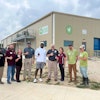
With the U.S. poultry industry well into the third year of the highly pathogenic avian influenza (HPAI) outbreak, the conversations are much different than they once were.
Lindy Chiaia, National Turkey Federation (NTF) vice president of scientific and regulatory affairs, said that cases of HPAI in commercial poultry flocks were greatly reduced in early 2024 when compared to the previous couple of years. As a result, NTF and others in the industry were able to focus more attention on other animal health issues like turkey reovirus and avian metapneumovirus.
But that all changed in March, when some young goats in Minnesota tested positive for H5N1. It was no longer just birds and carnivorous mammals getting infected.
“That was the first time that we were hearing of livestock detection, and so that of course raised some different ears and eyes,” Chiaia said while speaking at PEAK on April 17 in Minneapolis.
Then about a week later, the first cases of H5N1 were detected in dairy cattle.
At the time Chiaia was speaking, the U.S. had had 28 confirmed cases of the virus in cattle. And it has also reached a human.
“Shortly after we started doing the livestock detection, there was the second confirmed human infection of HPAI in the United States. So, there’s a lot of questions right now. You had an outbreak that was continuing for three years, but it was slowing down,” she said.
But if concerns about HPAI were once lessened, that certainly isn’t the case now. In fact, it has the attention of people who may not have previously given it much thought.
“The situation has changed. It is ever-changing every day. The conversation is different, but the spotlight is probably brighter than ever,” said Chiaia. “Because when you start having human cases, that changes a lot of perspectives, and a lot of the folks are paying attention to the news articles. It piques the ears and eyes both on Capitol Hill and with reporters, and so there’s a lot more light coming to the outbreak and that’s one that were working through as an industry.”
Rethinking biosecurity
Chiaia said the positive detections in mammals is prompting those in the turkey industry to rethink biosecurity.
In the past, when the NTF was speaking to its members about biosecurity, they would often ask if the farm operators and workers had been in contact with backyard poultry or other birds. And while those are still good questions to ask, they are now thinking about other animals.
“We’ve never once on a biosecurity questionnaire have asked: ‘Have you ever been around cattle? Have you been around other livestock?’ So, (we’re) just expanding that what-if scenario and identifying how you can better mitigate that risk,” Chiaia said.



















